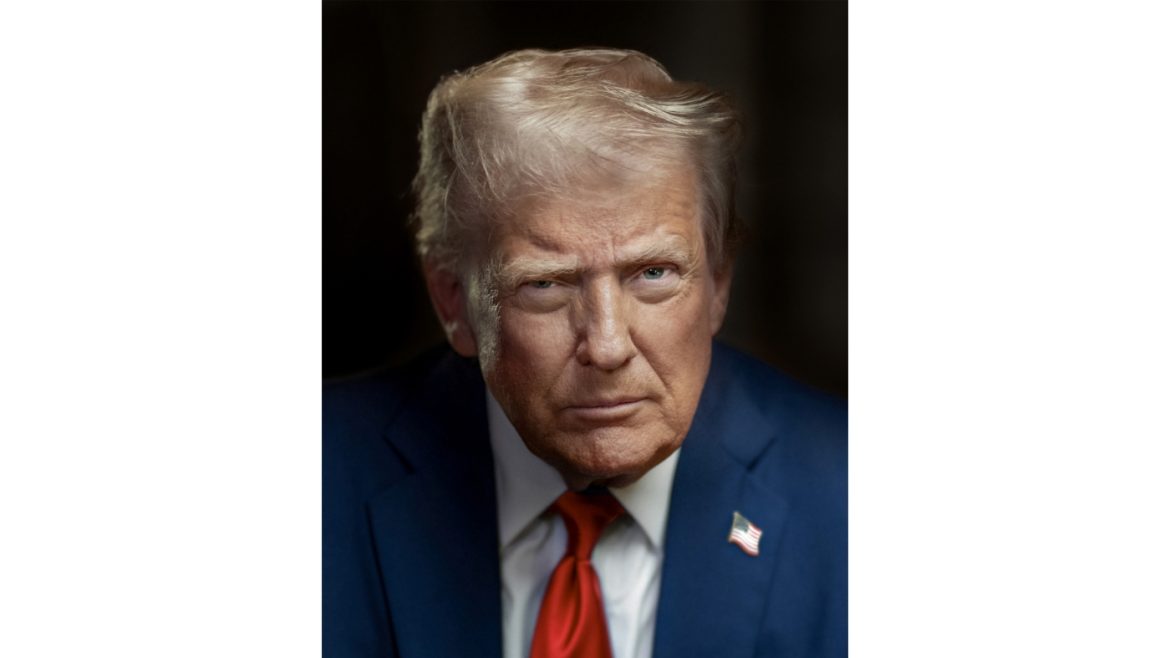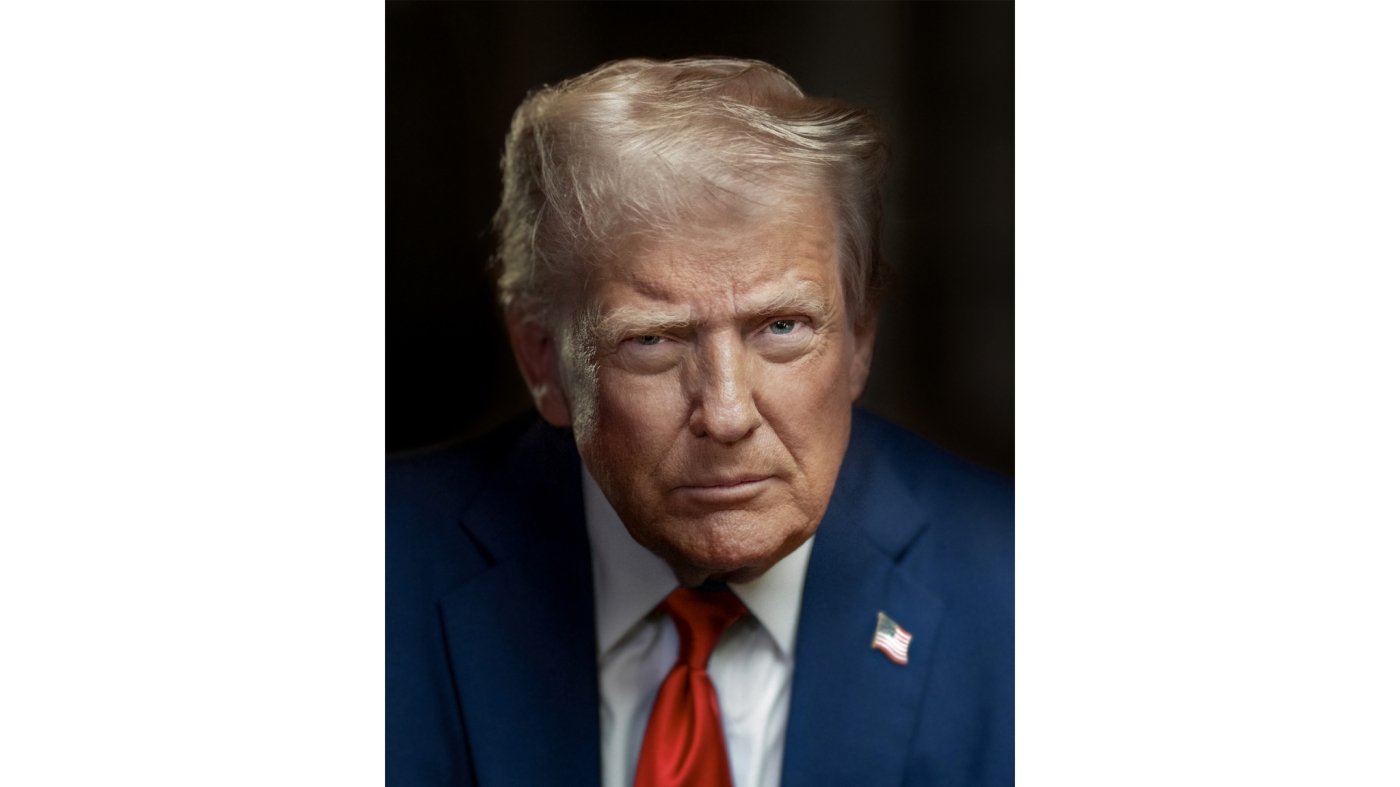A New Era in Presidential Imagery: Donald Trump’s Official Portrait Unveiled
The recent unveiling of President Donald J. Trump’s new official portrait at the White House has set tongues wagging, signaling a significant shift not only in how the 45th and now 47th U.S. President is visually represented but also in presidential portrait tradition itself. This detailed analysis unpacks the elements, symbolism, and public reception surrounding the newest presidential likeness, revealing how it reflects Trump’s persona and political narrative while breaking from time-honored conventions.
—
Portrait Setting and Visual Composition: Darker, More Intense
A departure from the more traditional, openly lit and flag-adorned presidential portraits, the new Trump image casts him against a markedly darker, somber backdrop. Unlike his 2017 inauguration portrait where he smiled broadly in front of an American flag, this rendition places him in stark relief, with deep shadows partially obscuring his shirt and parts of his face, imbuing the composition with a dramatic presence and an almost enigmatic aura.
Visually, Trump is depicted wearing a blue suit jacket complemented by a crisp white button-up and a striking red tie, a sartorial choice consistent with his political brand identity. The blue suit signifies patriotism and stability, while the red tie echoes power and assertiveness — staples of Trump’s public image. This combination contrasts against the dark background, drawing viewer focus directly to the president’s face.
His direct gaze into the camera, with his right eye slightly squinted, communicates a piercing, resolute demeanor. The expression balances seriousness with restraint, lacking overt emotion, which diverges from previous portraits where presidents tended to display approachable or statesmanlike warmth. The portrait’s close-cropped framing enhances intimacy but also intensifies the sense of scrutiny, suggesting an unflinching confrontation with the viewer.
—
Breaking Tradition: A Bold Reimagining of Presidential Portraiture
One of the most talked-about aspects of this new portrait is what was deliberately left out. For over fifty years, U.S. presidential portraits consistently featured the American flag in the background, a visual anchor symbolizing national identity and unity. Trump’s new portrait notably eschews the flag, drawing attention both domestically and internationally.
This absence subtly signals a break from tradition and could be interpreted in multiple ways: a stand-alone portrayal emphasizing individual leadership over collective symbolism, or reflecting a more contentious relationship with established institutions and political norms during Trump’s tenure. The stark, neutral backdrop also diverges from the warmer and more inviting tones typical of predecessors’ official portraits, underscoring a theme of gravitas and perhaps confrontation rather than consensus.
Additionally, experts and critics have noted nuances in the portrait’s execution—such as shadowing and subtle photo retouching—that appear carefully crafted to create a complex, layered image, avoiding a straightforward photorealism or idealization.
—
Political and Symbolic Messaging: Aligning Image with Ideology
Trump’s portrait arrives after a landslide re-election victory and ahead of his second term, positioning the image as a visual manifesto of his renewed mandate. The serious, unsmiling expression and direct stare project strength, resolve, and an unyielding character, resonating with his brand of political messaging that rejects radical leftist policies and champions “tangible quality of life improvements” for Americans, as stated by his administration.
The portrait’s darker tones and minimalist background could be seen as underscoring a narrative of seriousness and urgency, perhaps reflecting Trump’s often combative and polarizing style in office. The red tie acts as a visual signifier of conservative power, aligning the image with his base’s expectations of leadership toughness.
While the portrait is less about symbolic national unity and more focused on the individual, the subtle inclusion of an American flag pin on the lapel maintains a link to patriotism, offering a nod to the institution Trump leads without diluting the centralization of his political persona.
—
Public Reception and Institutional Implications
Unveiled via official White House channels such as X (formerly Twitter) and embedded immediately in formal government display locations like the Eisenhower Executive Office Building, the portrait has sparked discussion among media and the general public alike. Some commentators embrace the intensity and modernity of the new portrait, viewing it as a fitting reflection of Trump’s historic and controversial presidency.
Conversely, others critique the departure from warmth and tradition, suggesting the image’s darkness and stark mood may alienate or symbolize divisiveness. Comparison with previous presidential portraits highlights Trump’s willingness to redefine presidential iconography on his own terms rather than conforming to decades-old customs.
Interestingly, this portrait also surfaced amid broader controversies surrounding National Portrait Gallery leadership and institutional politics, further embedding it within the ongoing narrative of Trump’s complex relationship with Washington and federal cultural establishments.
—
Conclusion: A Portrait Reflecting a Complex Presidency
President Donald Trump’s new official portrait marks a significant evolution in presidential portraiture — one that eschews traditional symbolism in favor of a darker, more intense, and highly personal visual identity. Its deliberate choices in composition, expression, and background break with long-standing conventions, reflecting the turbulent, confrontational, and unapologetically bold nature of Trump’s political career.
By portraying Trump with an unsmiling, direct gaze framed against shadows, the portrait encapsulates the themes of strength, defiance, and individuality that have characterized his leadership style. Whether admired as a powerful political statement or debated as a departure from presidential norms, this portrait will undoubtedly be a defining image of early 21st-century American political iconography — one that invites viewers to confront the complexities and contradictions of the presidency it represents.


